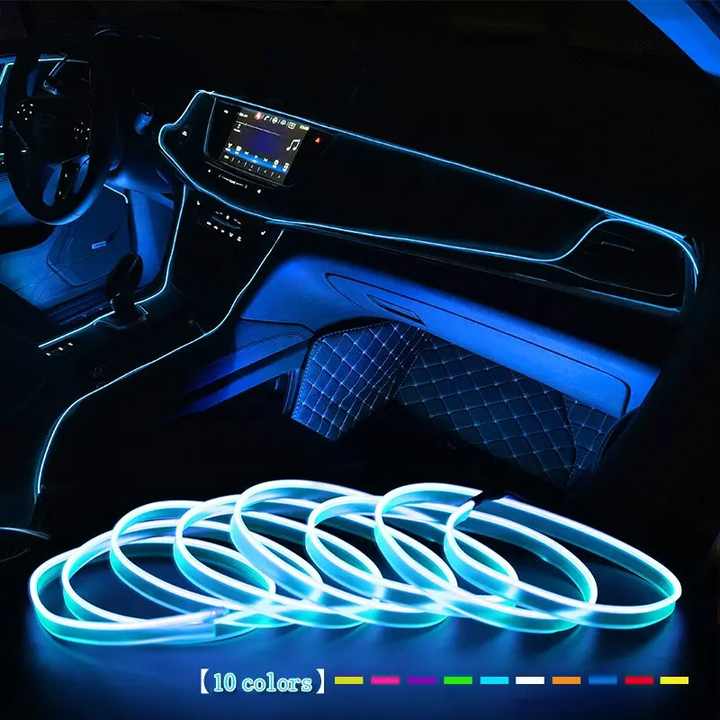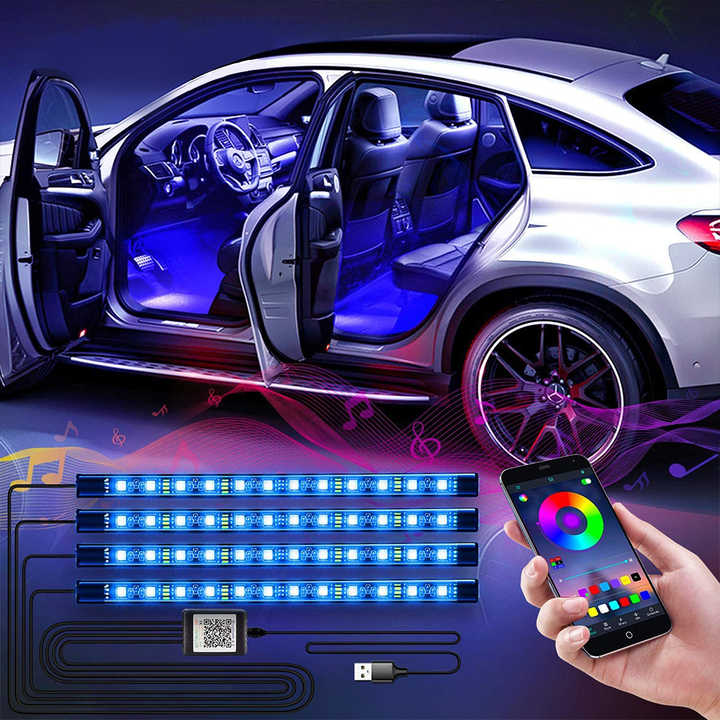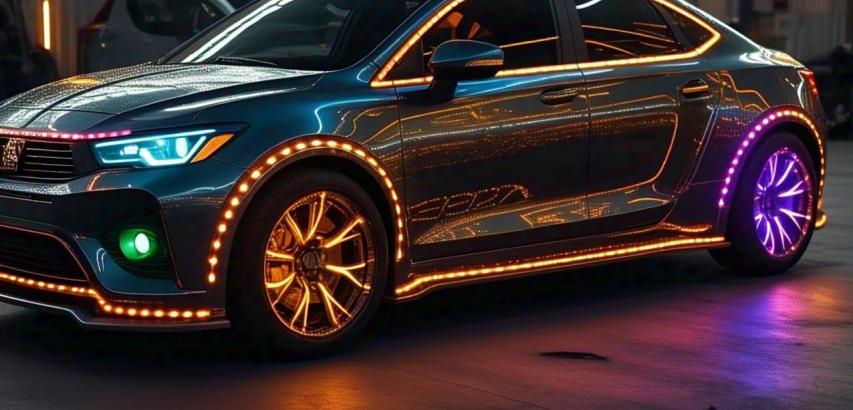Car LED light strips are flexible, adhesive-backed strips containing multiple small Light Emitting Diodes (LEDs). They've become immensely popular for automotive customization, offering both aesthetic enhancement and practical lighting solutions. Available in single colors (like white, red, blue) or multi-color RGB/RGBW variants, they can transform a vehicle's interior or exterior ambiance.
Types & Applications
Interior LED Strips:
Footwell Lighting: Adds soft illumination to driver/passenger foot areas.
Dashboard/Console Accents: Highlights contours, cup holders, or storage bins.
Door Panel/Trim Lighting: Creates a "halo" effect around door edges or trim pieces.
Cargo/Trunk Lighting: Improves visibility in dark storage areas.
Ambient Mood Lighting: Sets a relaxing or sporty atmosphere inside the cabin.
Exterior LED Strips:
Underglow/Neon Kits: Mounted under chassis, rocker panels, or bumpers for dramatic ground effects (Note: Legality varies significantly - see below).
Grille Lighting: Accents the front grille.
Headlight/DRL Accents: Thin strips used as Daytime Running Lights (DRLs) or to accent headlight assemblies (often require specific brightness/compliance).
Trunk/Decklid Accents: Lines the edge of the trunk or spoiler.
Wheel Well Lighting: Highlights the wheels (less common).
Key Features & Specifications
Flexibility: Easily bends around curves and contours.
Waterproofing (IP Rating): Crucial for exterior use. Look for IP65 (splash/dust resistant), IP67 (temporary immersion), or IP68 (continuous immersion).
Density: LEDs per meter (e.g., 60/m, 120/m) affects brightness and smoothness.
Brightness & Color: Measured in Lumens. Color Temperature (Kelvin - K) for whites (e.g., 6000K = cool white). RGB offers millions of colors.
Voltage: Typically 12V DC (matches car electrical system).
Control:
Basic: Simple on/off switch.
Color Changing: Requires an RGB controller (often included).
Smart Control: Bluetooth/Wi-Fi apps for smartphones (change colors, patterns, brightness, sync to music).
Cuttable: Most strips can be cut at marked intervals (e.g., every 3 LEDs) to fit specific lengths.
Installation Basics
Power Source:
Cigarette Lighter (12V Socket): Easiest, plug-and-play. Limited to interior use.
Fuse Box (Add-a-Fuse Tap): Common professional method. Taps into existing circuits (e.g., accessory or interior lights).
Direct to Battery: Requires proper fusing and switch/relay control. Best for high-power or exterior kits.
Wiring: Requires connecting positive (+) and negative (-) wires correctly. Soldering or waterproof connectors are recommended for reliability.
Mounting: Clean surface thoroughly with alcohol. Use the strip's adhesive backing. For longevity or harsh environments, additional adhesive (like 3M VHB tape) or mounting clips may be needed.
Controllers: RGB/RGBW strips require wiring the controller between the power source and the strip. Follow manufacturer diagrams.
Benefits
Aesthetics: Dramatically enhances vehicle appearance (interior/exterior).
Customization: Vast color/pattern options (especially RGB).
Ambiance: Creates mood lighting inside the cabin.
Visibility (Interior): Improves usability at night (finding items, footwells).
Energy Efficiency: LEDs consume far less power than incandescent bulbs.
Long Lifespan: LEDs typically last tens of thousands of hours.
Durability: Resistant to vibration (no filaments).
Important Considerations & Drawbacks
Legality (Exterior - ESPECIALLY Underglow):
Varies Wildly: Laws differ by country, state/province, and sometimes even city.
Common Restrictions: Colors like blue/red (often reserved for emergency vehicles), flashing lights, brightness levels, and where lights are visible while driving (e.g., front/sides/rear). NEVER use red on the front or blue anywhere unless explicitly legal in your area.
Driving vs. Show Use: Many places allow underglow ONLY when parked (off-road/show use), not while driving on public roads. RESEARCH LOCAL LAWS THOROUGHLY BEFORE INSTALLING EXTERIOR LIGHTS.
Quality Variances: Cheap strips may have poor adhesive, inconsistent colors, dim LEDs, or fail quickly. Waterproofing on cheap strips is often inadequate.
Installation Complexity: Requires basic electrical knowledge. Improper wiring can cause shorts, blown fuses, or damage.
Potential Warranty Issues: Modifying electrical systems might void parts of your vehicle warranty.
Taste: Overuse or overly bright lighting can look tacky.
Distraction: Interior lights should not impair driver vision at night.
Purchasing Tips
Define Purpose: Interior ambiance? Functional lighting? Exterior show?
Choose Type: Single color? RGB/RGBW? Waterproof rating?
Check Length & Density: Measure carefully! Higher density = smoother light/better brightness.
Assess Quality: Look for brand reputation, genuine waterproof ratings (IPxx), copper PCB (better conductivity), and quality adhesive.
Controller Needs: For RGB, ensure the controller offers desired features (app control, patterns).
Wiring Kit: Ensure you have the correct wiring harness, fuses, and connectors. Kits often include these.
Reviews: Read user reviews carefully.
Car LED light strips are a versatile and popular way to personalize your vehicle and enhance its functionality. While interior lighting is generally safe and straightforward, extreme caution and thorough legal research are ABSOLUTELY NECESSARY before installing any exterior lighting, especially underglow. Prioritize quality products and proper installation for safety, longevity, and the best visual effect. When used tastefully and legally, LED strips can add a unique and impressive dimension to your car.
 |  |  |
Buy Car LED Light Strips - Amazon
 |  |  |
